That Daytona 500 repave: Goodyear's Stu Grant's Take
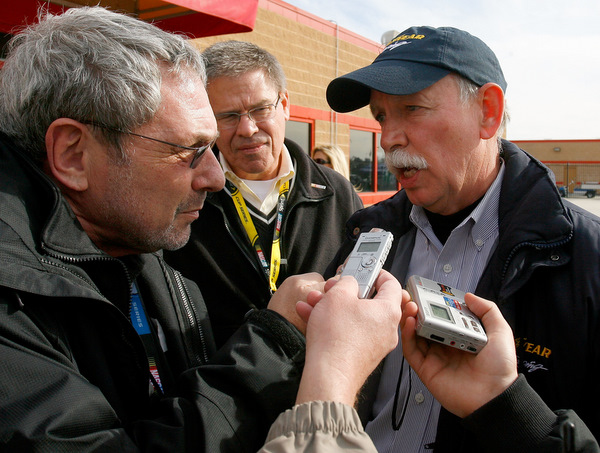
Goodyear's Stu Grant (Photo: Getty Images for NASCAR)
By Mike Mulhern
mikemulhern.net
RICHMOND, Va.
Will a repaved Daytona become Talladega II?
That's what some drivers suspect...even fear.
Certainly new smooth asphalt will change the face of racing at the legendary track.
"I think Daytona could become the new Talladega -- with more carnage because it's so narrow," Talladega winner Kevin Harvick frets about next year's season-opening Daytona 500.
That's the view from behind the wheel.
What about the view from the guys at Goodyear, who have to provide the rubber?
Daytona will be a much faster track, with the new asphalt and better corner transitions. (When Daytona was last repaved, in 1978, speeds jumped nearly 10 mph. After Talladega's 2006 repave, speeds went up three mph, even after engine horsepower reductions.)
Regardless of speed – which NASCAR can now keep under control -- new asphalt at Daytona looks like it could put Goodyear engineers under the gun.
But not really.
It all depends on how fast Daytona can get that asphalt down and cured for testing. The time frame would hopefully be between Nov. 1 and Dec. 1....the Jan. 1 completion date set by Daytona officials is likely much too late, considering the amount of testing that needs to be done, by Goodyear, by NASCAR, and by stock car teams themselves.
Compounds for new asphalt -- once dreaded from a race tire standpoint, because of high temperatures generated – have become well engineered over the past several years, with repaves at tracks all across the stock car tour.
But now Goodyear looks like has some magic formula. What changed?
"It's not so much us as it's the asphalt itself," Grant says. "The pavers have all gravitated toward this particular type of asphalt -- with small aggregate, compact, and with resins in it that holds it together. It just produces a very nice surface.
"In the past we were all at the mercy of the local paver, at that particular area, and whatever they used – coarse or tight or whatever.
"Now they're pretty good at giving us a good surface to test on."
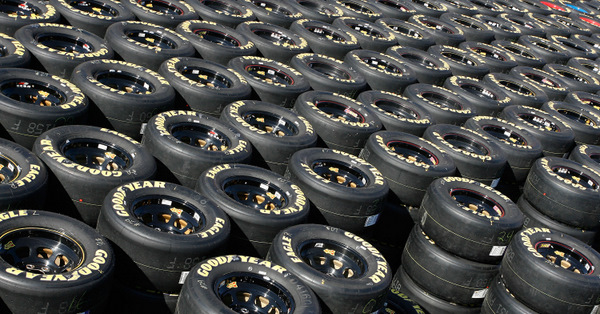
The bottom line for Goodyear: it has to have 6,000 new tires at Daytona for the 2011 season opener (Photo: Getty Images for NASCAR)
In fact the new Daytona asphalt could be a plus for Goodyear, because the old, worn-out asphalt was so abrasive that tire wear was typically an issue.
Of course drivers and crew chiefs liked that abrasive asphalt, because it made handling and tire strategy more critical.
Eliminating those jarring first turn bumps isn't the only structural change planned for the 2.5-mile oval. The corner transitions are expected to be tweaked too, such as changing the exit from the second corner onto the backstretch to alter the abrupt drop-off.
Daytona executives have set a completion date of January 1st for the whole job, but Stu Grant, head of Goodyear's worldwide racing operations, says "We need to get on the new asphalt as soon as possible.
"When they said it would be finished by January 1st, I said we've got to get on it before that."
The Talladega repave in 2006 took five months, from start to race day.
Daytona's repave is to start early July, right after the Fourth of July 400. That means the new surface should be race-ready by sometime in late November.
"We have some solid baseline repave from this Talladega repave, and Daytona says it will use a similar aggregate. So we can do internally coefficient of friction studies, and have some idea what the surface will be like. And we can compare the old Talladega to the new Talladega, and see what kind of leap we had to make to do that.
"We can do all that up-front work....But in the end we have to get on the track with a real race car and real tires."
Normally Goodyear starts building Daytona tires in the middle of November, and tires for the following spring's first four or five races, because this sport requires 3,000 to 5,000 new tires each weekend.
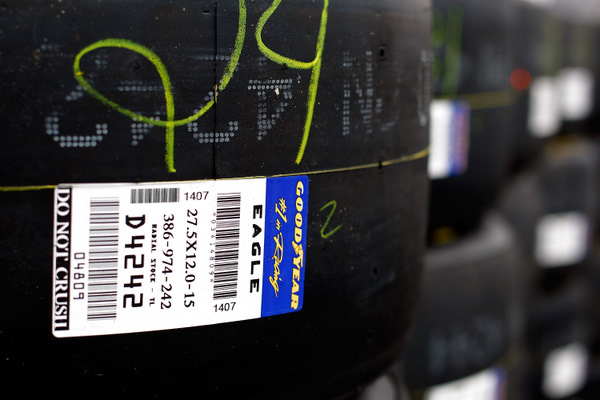
Goodyear has 25 different types of NASCAR tires this season, D-coded (Photo: Getty Images for NASCAR)
"We can leap over Daytona and start making tires for California and Atlanta....but we need to get on the track at Daytona before January 1st," Grant says.
In fact, looking at this fall's Sprint Cup schedule – The October run is Kansas City, Fontana, Calif., Charlotte, Martinsville, and Talladega, leading into November's run from Texas to Phoenix to Homestead-Miami, all eight on consecutive weeks – it would appear the best time to try to get in some major testing on the new Daytona track would be late October.
And how long might it take to cure the new asphalt? Another issue to consider.
But Grant says he could go later. "We have tested in December before (for Atlanta); we can test pretty much all 12 months.
"But we have to make 6,000 tires (for Daytona)."
Plan B? "We'll have Plan A, Plan B and Plan C...because it's the Daytona 500," Grant says. "And we need to get on that track with a large number of cars."
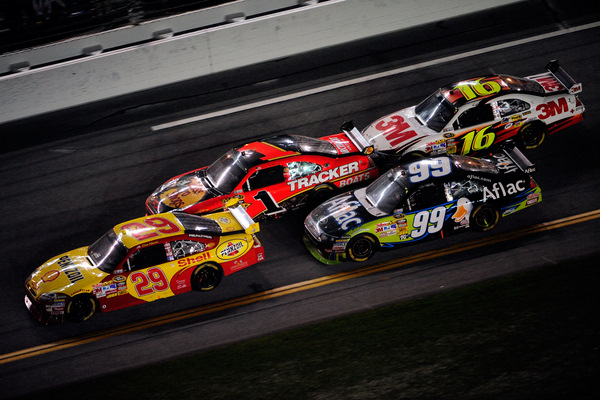
Daytona may be a lot smoother with the repave...but it's going to be just as narrow (Photo: Getty Images for NASCAR)
And NASCAR too, because it will have to decide what to do with restrictor plates, rear-end gearing and rear spoilers. That will likely mean at least a two-day Daytona test with some two dozen Cup drivers.
But when?
"We had some pretty darned good success with the 17-car test we had (at Daytona) in the fall of '09 (Nov. 2-3), getting ready for Daytona 10. That gave us the best Daytona tire we've had in a long time. That worked well for us.
"So my thought is to go back again like that: to get a lot of cars out there, sliding around."
After all, a major part of designing a stock car tire is dealing with the side-bite – making the cars stable in the draft, so drivers won't worry about moving around.
The current Daytona surface is abrasive. "It is a very, very abrasive surface, tough on tires, just ripping that rubber off because it's so rough, just tear and chunk the tires," Grant said.
"But repaves are always a challenge too, because we've got to get the gauge of the tread rubber just right, because we've got to get the wear-rate right and get the heat-resistance right right.
"The biggest issue for us is 6,000 tires. And there really isn't enough time to do a tire test in the middle of January."
And not all 6,000 tires will be the same left-right combination, Grant said, because the three different cars racing there in February – Cup, Nationwide and Truck – all have different downforce parameters, putting different loads on the tires. For example Trucks have the most downforce, Nationwide cars about 20 percent less, and Cup cars another 12 to 20 percent less.
On top of that, NASCAR is introducing a new Nationwide car, on the Cup car-of-tomorrow design, which is another wrench in the mix. That new car won't be on the track racing until Daytona in July. (Testing is set there for May 18-19, but how many teams will be involved isn't clear yet.)
"It would nice and simple and straightforward for everyone, the teams and Goodyear, if we had just one tire combination," Grant said. "But we are sensitive to the issue of having the right tire for each particular vehicle. We don't want to compromise too much."
Goodyear has 25 different tires this season. "I think 18 is about as low as we ever got. And it's been going the other way lately," Grant said.
"It really makes a big difference if you can zero in on the right compound for a specific track."
Will Daytona become just another Talladega? Freight-trains of cars, tightly packed together from start to finish over each 100-mile run?
"Daytona has always been a handling track, more than Talladega, because of the trioval, and that will probably still be the case," Grant says. "So our starting point will be with the current Daytona mold, because that (design) gives you the handling you need to get around that. Then it's just a matter of finding the tread compound to match the surface."
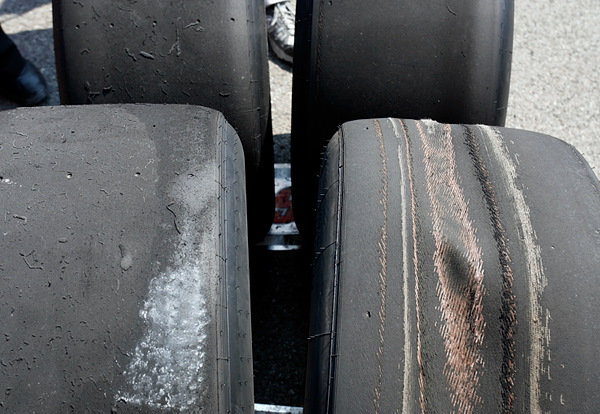
The summer of '08 was not Goodyear's finest hour. Brickyard 400 tires lasted only 10 laps and then looked like this. But that prompted big testing changes at the company, and it's been on a roll ever since. (Photo: Getty Images for NASCAR)
Goodyear, ever since the Indianapolis debacle in the summer of 2008, has been on an amazing hitting streak. Rarely if ever are drivers complaining much any more. And Goodyear's new designs have clearly made for better racing.
What the heck happened? Who lit the fuse?
Grant smiles, and knocks on wood: "You can attribute that directly to the amount of testing we've been doing.
"We have been doing a heck of a lot of testing.
"For a long time we were reluctant to changes things. You've been around this garage a long time, and you know these guys don't like a lot of change.
"So if you kept the setups the same from spring (race) to fall (race), it made it easier on everyone.
"But when we went to this new car-of-tomorrow, we had to throw that out the window....and get aggressive on testing, because we've had to make a number of changes in mold and design."
Basically because the car-of-tomorrow is a physics nightmare, with a higher center of gravity and other technical aspects that make it a handful not only to driver but to engineer around, for crew chiefs and Goodyear engineers alike.
"It took us a while to get our hands around it," Grant said. "In '08, remember, they rolled this car-of-tomorrow everywhere....and teams weren't that clued in to how to tune the car, and the tires didn't really suit the car...
"There were a lot of issues...and we weren't helping too much either, because we had a lot of work to do to make the setup more raceable.
"So we don't get all the credit. Certainly the testing we've done has helped. We're doing a lot more testing than we did.
"And these guys are doing a better job of tuning the cars too.
"And the racing has been really good."
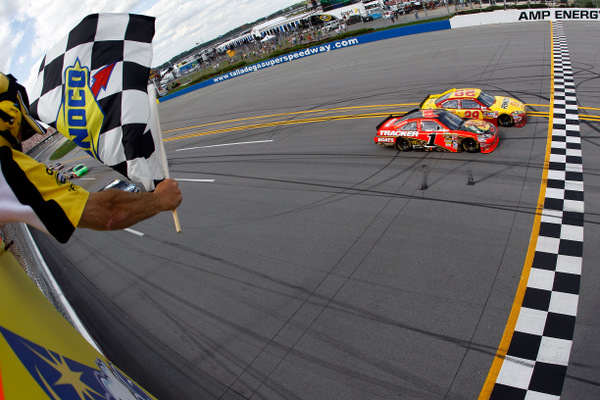
Talladega is nice and wide....Daytona isn't (Photo: Getty Images for NASCAR)
One big product from the fallout from the 2008 Brickyard is that Goodyear has learned a lot more about tire wear, how to design for it at different tracks, and how to manage it better. The problem at that race was that tires didn't lay down rubber; the tire, as it wore, simply powdered, and wore out in 10 laps.
"We learned a lot about wear and the whole mechanism of how rubber wears on an abrasive surface like Indianapolis and how to adjust the compound to improve that.
"And we have learned how to adapt that to a lot of other tracks that had similar characteristics, like Dover (concrete) and Bristol (concrete) and Martinsville, and improve that racing too."
And then that was that new Martinsville tire sealing bead last month? Goodyear came up with a tougher, more heat-resistant bead, to combat the common problem of brake heat melting the bead and blowing tires.
"We found a compound that gives us a higher melting point," Grant said.
But drivers just used their brakes that much harder and still blew tires.
So what is the toughest NASCAR track on tires this season?
Once it was Talladega: Remember 1969, when Talladega first opened: it was the perfectly engineered race track, designed for flat-out racing, with perfect corners.
The only problem was it was too fast for the tires. They kept blowing up. Drivers boycotted the race. Firestone dropped out of the sport entirely. Goodyear had to rethink its entire tire theory.
"The original 'Talladega tire' was built on a special mold, to help carry the load created by these race cars at these speeds," Grant said.
"But as things have evolved, like going to the radial tire (1989), and as we have gotten better with our tire constructions and mold shapes, the Talladega tire now is pretty much the same mold shape and construction as our other tires."
During the infamous tire wars with Hoosier, it became clear that the toughest track on the tour was Dover. Then Texas....sometimes Atlanta, with abrasiveness.
Today?
"Las Vegas is now the toughest track out there, where we need the toughest tire, because of the peak load in the variable banking, with those speeds," Grant said.
"But right now our biggest challenge is the Daytona repave...to make sure we have a good tire for the Daytona 500 2011."
[Note: You can use Twitter as an easy headline service for mikemulhern.net stories, with our instant Tweets to your mobile as soon as our newest NASCAR story is filed. And mikemulhern.net is mobile-friendly for viewing. You can also use the orange RSS feed button as a quickie headline service on your laptop or home computer for mikemulhern.net stories, by creating a Live Bookmark RSS feed on your web browser's toolbar. Or you can create a Google Alert for mikemulhernnet.]

Goodyear has made quite a turnaround since Indy 2008 (Photo: Getty Images for NASCAR)
© 2010-2011 www.mikemulhern.net All rights reserved.
Web site by www.webdesigncarolinas.com







To me, the most worrisome
To me, the most worrisome aspect of the repaving is the smoothing of the transitions. The sharp transitions at Daytona made handing much more important than at Talladega. That led to some separation of the cars during longer runs. Without the sharp transitions, Daytona will just be another Talladega. The Great American Race is about to get a little less great.
actually smoothing that
actually smoothing that dropoff off turn two should be a big plus....too many crashes over there, typically. a better exit transition should make for more passing on the backstretch.....the thing i agree with gil martin on is the agregate -- make it a little more coarse so it does wear the tires a little, so there is separation over a 100-mile run.....they ought to do the same thing at darlington too....imho
I am sick and tired of people
I am sick and tired of people who want some kind of separation in racing. Racing is lead changes, not handling; it is more, not fewer, cars fighting for the win. There is no such thing as racing that has any competitive worth when there is seperation over a 100-mile run.
The 500 this past February was made better when it transitioned to night and the track got more grip and thus handling became largely irrelevent to the outcome; the outcome became about the draft and outfighting the field.
Making tires wear doesn't make for great racing; the sport found this out in the Hoosier Tire wars when the sport saw races where contenders/winners won by skipping tire changes, and this phenomenon returned in 2001-2 when Goodyear brought ultra-hard compounds for high downforce and teams could skip tire changes and actually had to speed up to go faster instead of slow down to go faster; with this package of tire and downforce the sport saw 26 winners among 14 different teams, numbers softer tires have never been able to reach.
Gil Martin is thus wrong. The new pavement needs to be smooth and the dropoffs in the corners need to be smoothed out so handling becomes less important than the draft. Daytona needs to be more like Talladega because that is the real template for racing - racing where the draft matters and handling doesn't; where the only way to win is to go for the lead and track position is about the drivers passing the field under green.
i agree to a point with you
i agree to a point with you Daytona needs a little separation but we dont have to make it easier to race the joint. would you watch the world series if they changed the rules to T ball and shortened the field to make it harder to run the bases? no, you would laugh. close racing is great i love dega but i love it even more now that it is aging a little. when a track is too sticky it can get a little boring foot to the peddle , tho my boy junior will stand a better chance if its about draft and not handling: 90% chance 88 1st at the 500
Post new comment